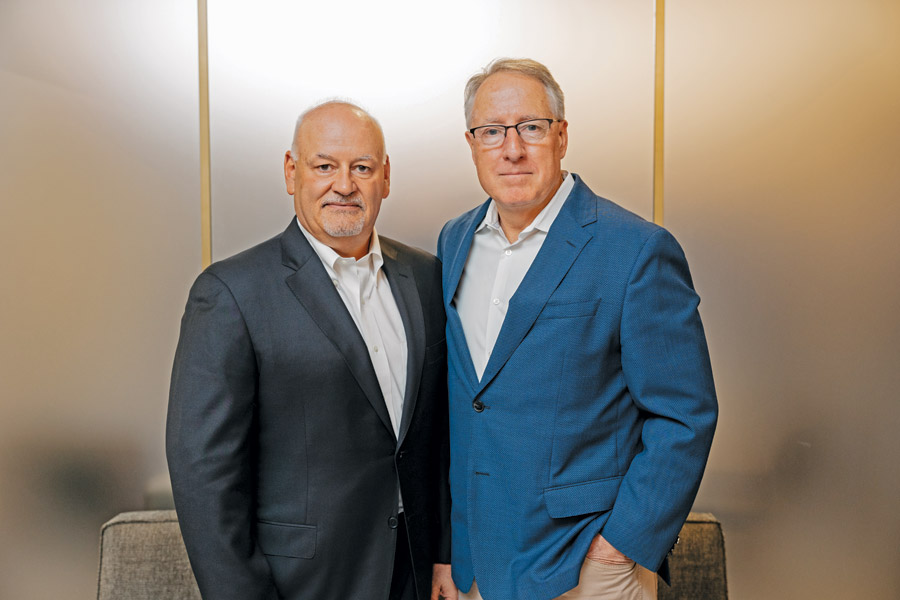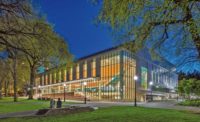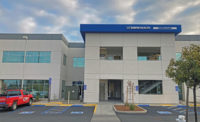Lance Franklin and Frank Reich, co-founders and co-CEOs of New York City-based Triton Construction Co., would like to say they planned the firm to be a leader in regional nonunion construction, but gaining that position in a region long dominated by organized labor happened by fate. They began their careers in union construction—both had been with Turner Construction—but decided to break into nonunion work just four years after Triton’s founding in 2002.
“Triton has always been at the forefront of that world, trying to push our subcontractors to perform like a union subcontractor in terms of safety, quality and workforce—things that as a union construction manager, where we came from, we were used to,” Franklin says.
Triton was one of the city’s first open-shop CM firms to have an in-house corporate safety program during the pandemic. “We continue to try to strive for not only Triton’s people, but also for our subcontractors and partners to be absolutely safe and to just build a better project,” Franklin says.
After more than 20 years in business, the firm continues to thrive. Regional revenue reached $396 million in 2022, holding steady year over year and placing Triton at No. 19 on ENR New York’s 2023 Top Contractors ranking, down two spots from last year.
Being a regional open-shop leader has driven the company to pursue and nurture relationships with different kinds of industry firms. “We were one of the first open-shop CMs to truly try to push more union grades on our projects. We were able to get a lot of union subcontractors,” Franklin says. “Almost every job we currently have is a blend.”
Today, Triton is the only open-shop CM building a 100% union project with a project labor agreement: 311 West 42nd St. in Manhattan. The 370,000-sq-ft, $337.7-million job, which includes union funding, covers a city block and features a 32-story tower and an eight-story extension near the Port Authority of New York and New Jersey bus terminal. “We try to ensure that we keep almost all our projects open for union participation,” Reich says. “We even solicit union contractors to work on our jobs because that really just develops long-term relationships on both sides.”

Triton Construction co-founders and co-CEOs Lance Franklin (right) and Frank Reich established the non-union company in 2002.
Photo by CEOportrait Headshots NYC
Adapt to Thrive
Construction cost escalation, materials and worker shortages and shipping delays were key issues in 2022, so understanding that owners could not necessarily sell or occupy a building for the same cost was vital, especially since budgets for some projects were done years earlier, in 2021 or even 2020, Franklin says. Triton’s team committed to value engineering and working closely with subs to move those projects across the finish line.
“We found it most productive to solve each problem individually as it came up to keep moving the job forward,” says Josh Brooks, senior project manager at Triton. “In a time when it was very easy to throw your hands up at circumstances outside of anybody’s control, it took a strong team not to give up and to continually think creatively to solve all new and unexpected challenges.”
This commitment is part of the reason why the company has been able to generate regional revenue at a steady clip—rather than with huge hikes and dips—which is all by design. Between 2014 and 2016, when work on New York City condos was exploding, “We probably turned away close to $2 billion of work because we don’t want to grow crazy,” Franklin says. Instead, Triton shifted to focus on work in core and shell office construction, interiors, apartment buildings and K-12.
“We were one of the first open shop CMs to truly try to push more union grades on
our projects.”
—Lance Franklin, Co-CEO, Triton Construction
Even so, 2023 is tracking to be Triton’s largest revenue year yet, with plentiful work in K-12 and residential markets. “We do not want to be the largest CM in New York, but we want to be the best,” says Franklin. “How to be the best, in our humble opinion, is quality staff, quality subs and relationships with our owners.”
Although much of Triton’s current work is in the residential space, future work in affordable housing is up in the air with the lapse in June 2022 of New York state’s 421A tax abatement. The team is hopeful the incentive will be renewed, but that, along with rising interest rates on commercial loans, is challenging the residential sector.
Keeping nimble will help alleviate such market shift issues, with Triton’s leadership looking for new spaces to enter. One is federally funded electric vehicle infrastructure. “The $1.2-trillion [U.S. Infrastructure Investment and Jobs Act funding] package put $4.5 billion toward solar panels, battery storage and charging stations in November 2021. You’re starting to finally see that money get to the cities,” Reich says.
Major projects are on the horizon or even already starting in New York for this green infrastructure. Triton has started work on some EV-related projects and is looking into more, with the promise of ample work ahead.
Closeup: Triton Construction Projects
Among major company projects is 1245 Broadway, a 22-story boutique Class A office building in Manhattan’s NoMad district that has 200,000 sq ft of office space and ground floor retail. This job helped launch Triton Interiors, which completed about 80% of the building’s fit-out. Also underway is 42-06 Orchard Street, a 798,000-sq-ft, 69-story residential project with low-income units that qualifies for a state tax abatement. With an overall height of 800 ft from grade, it is set to be the tallest building in the Long Island City section of Queens. Outside of New York City, Triton’s work falls under owner agent contracts rather than the at-risk approach it takes in the city. Work includes a $157-million project for Uniondale Union Free School District in Long Island and a $103-million project for White Plains City School District in Westchester County.

This mixed-use, market-rate residential building in the Bronx was built next to and above a CSX rail freight line. It occupies an entire city block at the Third Avenue Bridge.
Photo courtesy of Triton Construction
Culture of Caring
Triton’s success is tied to the quality of its staff, Franklin says. “What sets us apart is that we really care. No job is without a partner, and that’s also why we don’t want to grow so much,” he says. “We don’t want to make it seem like it’s a big giant shop and our owners don’t have anyone to call.” As part of its goal to create a place where its staff of 125 enjoy coming to work, Triton relocated to a state-of-the-art office in Manhattan early in 2023 and implemented a host of technologies that burgeoned during the pandemic and have now become the norm.
“I have always appreciated the time and effort the partners put into hiring the right people for the job and encouraging long-term growth within the company,” Brooks says. “It has made for an amazing blend of self-driving, collaborative co-workers that put pride in their work.”
Partners note Triton’s focus on details. “I always like to say that Triton’s secret weapon is meticulous and detailed preparation,” says Michael Kirchmann, CEO of GDSNY, a New York City real estate investment and development firm that is working with the CM on four ground-up high-rise projects totaling more than 1 million sq ft in Manhattan. “Triton’s team is made up of a deep bench of talent with expertise in all areas of the construction process. Their analyses are detailed and demonstrate a seasoned knowledge of the New York City construction and development market.”
Triton is also building about 300,000 sq ft of Class A interior office fit-outs for GDSNY. Projects include 1245 Broadway, a 23-story office building at the corner of 31st Street and Broadway; 28&7, a GDSNY office building at the corner of Seventh Avenue and 28th Street; and a supertall building that will be over 1,000 ft tall on Park Avenue to be announced in 2024. “Their reputation for quality and reliability attracts the best in trades, which in turn is reflected in the end product to owners,” Kirchmann says.

Triton says employees are key to its success, and the firm has made it a priority to create a culture where they enjoy coming to work.
Photo by Piotr Kuzniar
Taking the Lead
Noting Triton’s early push on COVID-19 site safety protocol, Kirchmann adds that it “became widely adopted by other GCs in the city, and the [New York City Dept. of Buildings] did regular training for its inspectors on Triton sites to act as the working prototype to be rolled out on other jobsites in New York City. This effort is emblematic of Triton’s foremost focus on the safety and security of its workforce and skilled artisans.”
The firm also has boosted technology use—from wearables to augmented reality—to further improve safety efforts. “We don’t see the Triton safety program as unique but more of a reflection of our culture, our operational philosophy and the general belief that we have a responsibility to ensure the health, safety and protection of all team members,” says Paul Meli, the CM’s vice president of corporate risk.
Rather than employing a universal, generic safety program, Triton instead approaches projects individually—studying each to develop a specific safety and risk management strategy, he adds, noting that the firm’s experience modifier rate (EMR) is currently 0.82.
“I always like to say that Triton’s secret weapon is meticulous and detailed preparation.”
—Michael Kirchmann, CEO, GDSNY
This customized safety approach also brings clients back. The NYC Dept. of Buildings has repeatedly asked Triton to be part of safety week and has highlighted its approaches. Mental health’s role in safety was given particular attention this year, Meli says.
Triton’s leadership is optimistic about the future, but also wary, given uncertainty of work ahead. “We are going after markets that we think are going to boom. We are installing one of the first EV charging networks in a parking garage. Who knows where that leads to?” Franklin says. “We are excited but nervous,” noting the growth potential but also the market risk.
“What our brokers in New York are telling us is survive until ’25. That’s their model right now,” Reich contends. “We’re lucky enough to have backlog until then and we’re in a good position, but we don’t want to rest on our laurels. It’s always about creating other opportunities.”
Meanwhile GDSNY’s Kirchmann sees a lot of potential in working with the CM. “Triton’s investment in its people is what makes for an inspiring and, frankly, fun workplace environment for the extended teams on both sides,” he says.




Post a comment to this article
Report Abusive Comment